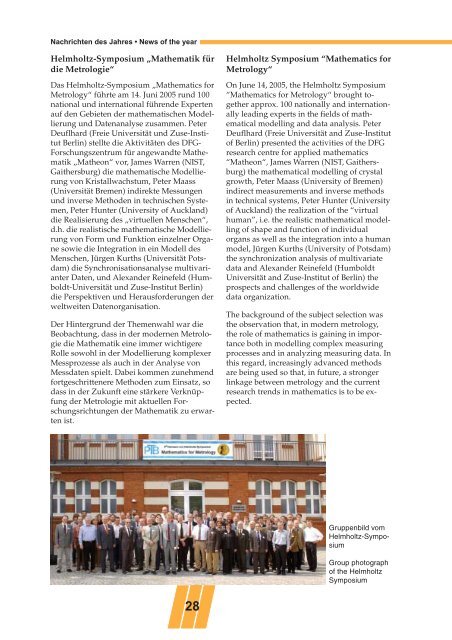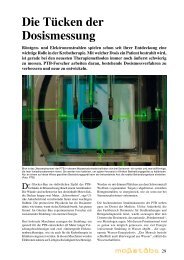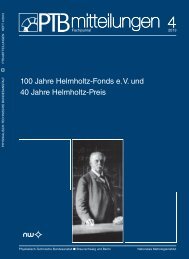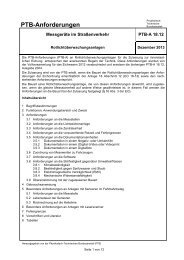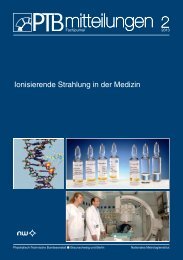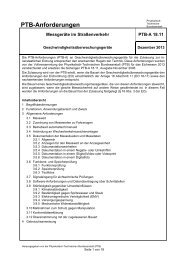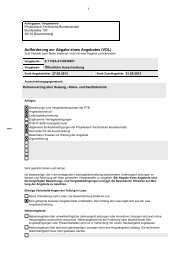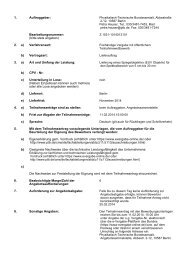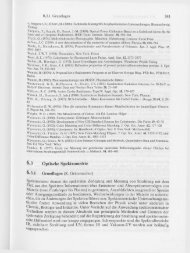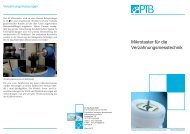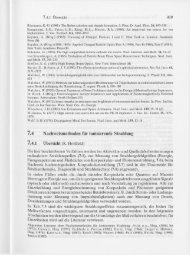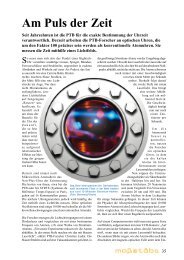PTB-Jahresbericht 2005
PTB-Jahresbericht 2005
PTB-Jahresbericht 2005
Sie wollen auch ein ePaper? Erhöhen Sie die Reichweite Ihrer Titel.
YUMPU macht aus Druck-PDFs automatisch weboptimierte ePaper, die Google liebt.
Nachrichten des Jahres • News of the year<br />
Helmholtz-Symposium „Mathematik für<br />
die Metrologie“<br />
Das Helmholtz-Symposium „Mathematics for<br />
Metrology“ führte am 14. Juni <strong>2005</strong> rund 100<br />
national und international führende Experten<br />
auf den Gebieten der mathematischen Modellierung<br />
und Datenanalyse zusammen. Peter<br />
Deuflhard (Freie Universität und Zuse-Institut<br />
Berlin) stellte die Aktivitäten des DFG-<br />
Forschungszentrum für angewandte Mathematik<br />
„Matheon“ vor, James Warren (NIST,<br />
Gaithersburg) die mathematische Modellierung<br />
von Kristallwachstum, Peter Maass<br />
(Universität Bremen) indirekte Messungen<br />
und inverse Methoden in technischen Systemen,<br />
Peter Hunter (University of Auckland)<br />
die Realisierung des „virtuellen Menschen“,<br />
d.h. die realistische mathematische Modellierung<br />
von Form und Funktion einzelner Organe<br />
sowie die Integration in ein Modell des<br />
Menschen, Jürgen Kurths (Universität Potsdam)<br />
die Synchronisationsanalyse multivarianter<br />
Daten, und Alexander Reinefeld (Humboldt-Universität<br />
und Zuse-Institut Berlin)<br />
die Perspektiven und Herausforderungen der<br />
weltweiten Datenorganisation.<br />
Der Hintergrund der Themenwahl war die<br />
Beobachtung, dass in der modernen Metrologie<br />
die Mathematik eine immer wichtigere<br />
Rolle sowohl in der Modellierung komplexer<br />
Messprozesse als auch in der Analyse von<br />
Messdaten spielt. Dabei kommen zunehmend<br />
fortgeschrittenere Methoden zum Einsatz, so<br />
dass in der Zukunft eine stärkere Verknüpfung<br />
der Metrologie mit aktuellen Forschungsrichtungen<br />
der Mathematik zu erwarten<br />
ist.<br />
28<br />
Helmholtz Symposium “Mathematics for<br />
Metrology“<br />
On June 14, <strong>2005</strong>, the Helmholtz Symposium<br />
“Mathematics for Metrology“ brought together<br />
approx. 100 nationally and internationally<br />
leading experts in the fields of mathematical<br />
modelling and data analysis. Peter<br />
Deuflhard (Freie Universität and Zuse-Institut<br />
of Berlin) presented the activities of the DFG<br />
research centre for applied mathematics<br />
“Matheon“, James Warren (NIST, Gaithersburg)<br />
the mathematical modelling of crystal<br />
growth, Peter Maass (University of Bremen)<br />
indirect measurements and inverse methods<br />
in technical systems, Peter Hunter (University<br />
of Auckland) the realization of the “virtual<br />
human”, i.e. the realistic mathematical modelling<br />
of shape and function of individual<br />
organs as well as the integration into a human<br />
model, Jürgen Kurths (University of Potsdam)<br />
the synchronization analysis of multivariate<br />
data and Alexander Reinefeld (Humboldt<br />
Universität and Zuse-Institut of Berlin) the<br />
prospects and challenges of the worldwide<br />
data organization.<br />
The background of the subject selection was<br />
the observation that, in modern metrology,<br />
the role of mathematics is gaining in importance<br />
both in modelling complex measuring<br />
processes and in analyzing measuring data. In<br />
this regard, increasingly advanced methods<br />
are being used so that, in future, a stronger<br />
linkage between metrology and the current<br />
research trends in mathematics is to be expected.<br />
Gruppenbild vom<br />
Helmholtz-Symposium<br />
Group photograph<br />
of the Helmholtz<br />
Symposium


